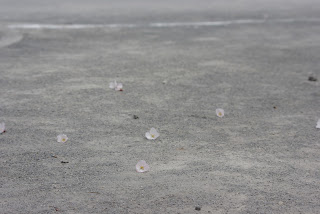It is hard to put into words the range of emotions and experiences one goes through during a week of recovery volunteer work in Ishinomaki, Miyagi on the northeast coast of Japan. The world watched live on television as the March 11, 2011 earthquake and tsunami shattered towns along the coast. I won’t rehash that story here.
On the night of April 30th I and a couple of guys from ball hockey climbed aboard a bus – one of nine departing that night – along with about 350 other volunteers for the overnight ride to Ishinomaki. Following all that an overnight bus ride on earthquake-roughened highways and the requisite stops to ensure an on-time arrival, we arrived bleary-eyed and stiff on the athletic practice fields of a university. This is where we would set up tents and camp for the week.
By mid-morning we were loaded on another bus and driven into the town itself. This was our first real look at the devastation the water had wrought. Along the cleared streets were mounds of timber, tatami mats, appliances, cars, boats, furniture, and everything else that can be imagined. Dust and dirt blanket the city. It was a quick and stark reminder that we had at most been slightly inconvenienced in Tokyo on March 11th.
We were told the area of town in which we would work had been protected from most of the raw force of the wave by a large hill. The area of town in which we would work had suffered massive flooding as the tsunami waves had moved up the river. The water crested about the second story of the buildings here. Although spared the full impact of the waves, there was enough power to put boats into some buildings, cars into other buildings and completely destroy other buildings and scattering whatever was inside.
Our team of six armed ourselves every morning with scoops, wheelbarrows and sacks. Each morning we were assigned a place to clean. Over the course of the week, our team was assigned parks, an elderly couple’s home, piles of debris and drying sludge outside a hospital, the storm drains between buildings, a couple of bars, and parking lots. We spent two days in those bars, each measuring only about 20 feet by 20 feet and came out looking and smelling like we had been working on a malfunctioning oil pipeline. Our team had it easy.
Northwest Japan catches and processes a lot of fish. Over two days during the week we were there, four other teams cleared an estimated 17 tonnes of dry and rotting fish from a small area of town. They achieved a level of minor celebrity and great admiration in the camp, as well as national television and internet news coverage. They were all easily identifiable. They were Fish.
During our lunch on the second day in Ishinomaki, the owner of the house where we were clearing the garden took us up the hill that protected this part of town. From the top is the incredible view of the ocean and the destruction left behind the retreating waves. He told us of people who had climbed onto their roofs to escape the rising waters, only to have the roofs torn loose and taken a kilometer or more out to sea. For the lucky ones, the next wave brought them back. One of his neighbors had grabbed a tree which was perhaps two inches in diameter at its base and stood on two small knots in as he held on while the waters rose to his chest, just out of reach of a balcony on the house.
One day we got bicycles to ride from camp to the work site. During our lunch and again after finishing work, we took the short ride around the edge of the hill and into the heart of the tsunami zone. Words and pictures are inadequate to convey what we saw and felt. It is something that must be experienced firsthand to be understood.
Electricity is on in parts of the town, as is water. During that first week of May gas companies from around the country were working to check the lines and restore service. Businesses are beginning to reopen, although with limited stocks. We found and frequented the open fruit and vegetable shops. The residents of the town are rebuilding, and there is a sense that although they have suffered, they will rebuild. They are grateful for the volunteers, and generously shared food and coffee with us. They are optimistic about rebuilding, but they are worried that interest will fade and they will be left without volunteers to help the community.
We were there during the annual spring holidays of Golden Week. Peace Boat, the organization with which we went, had 350 volunteers, including 41 non-Japanese. The following week they had registered about half of that. The week after just 60.
Two members of my team will return for shorter trips next month. Two others are talking about returning in August. I will be looking for my own opportunities to return later in the year.
There are a number of organizations running volunteer programs throughout the affected areas. The links to information below are those with which I have had personal experience.
Peace Boat
AP Bank (Japanese only)
Second Harvest Japan
If you cannot volunteer, but still want to help, I suggest donating to the Red Cross or to Doctors without Borders, or to Second Harvest Japan.



